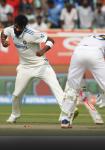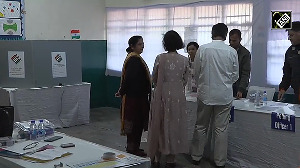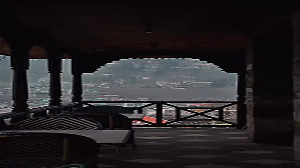Sheela Bhatt compares the Bannerji Committee report findings with the Gujarat police's investigation in the second part of her series on the Godhra case.
Part I: The politics of evidence
The Bannerji Committee report cannot be ignored.
Seventy-five intellectuals have sent a memorandum to Prime Minister Dr Manmohan Singh, seeking the immediately release of the 109 Godhra accused facing trial in the Prevention of Terrorism Act court in Ahmedabad, on the basis of the report.
The report was on the Sabarmati Express fire at Godhra station on February 27, 2002, which killed 59 passengers and lead to riots in Gujarat that claimed more than 1,000 lives, mostly Muslims.
According to the memorandum's signatories, 'no crime' was committed in Godhra. The Bannerji report's critics have termed it a farce with dangerous implications. The division of opinion on the Bannerji report deserves a debate.
With the help of Gujarat police records (which one can doubt but cannot ignore in view of their legal value in the eyes of the Criminal Procedure and Investigations Act), rediff.com presents the trail of the Godhra case.
Only the court, of course, can give its opinion on the merit of the evidence. rediff.com presents the Bannerji report findings along with the police findings that are in the public domain.
QUESTION 1
The Bannerji report alleges there has been preponderance of evidence that the fire in S-6 originated in the compartment itself without external inputs.
What the Gujarat police says
a. The police have a Forensic Science Laboratory (Ahmedabad) report certifying that more than 60 litres of inflammable material is needed to set on fire the compartment in the same manner as it was burned in less than 25 minutes. It says highly inflammable material was needed to burn it, as the compartment was relatively new, made of 'fire-retardant and self-extinguishing' material.
According to the police 120 litres of petrol were used and some jerry cans used to pour the petrol were found outside the compartment after the incident, that day. The cans are mentioned in the panchnama (a record of the situation when the police arrive at the scene of crime).
b. The police have confessions from two people of the private petrol depot in Godhra that made the supplies to the 'conspirators' a day before the event.
c. The railway ministry's institution based in Lucknow, the Research, Designs and Standards Organisation has corroborated the findings of the Forensic Science Laboratory report. It means cigarette butts or a gas stove cannot create enough heat to burn the compartment to ashes in a few minutes.
d. More than 60 surviving passengers gave identical 'eyewitness accounts' of their struggle to survive. They claim they saw fire spreading from the compartment's rear.
e. The Bannerji report claims 'some evidence of cooking inside the compartment by kar sevaks was given before the committee.' But in the forensic report, the burnt gas stove or residual of similar hazardous materials have not been found.
The Lucknow institute's experts believe the compartment -- particularly its ceiling and floor -- was made of material that cannot catch fire with the bursting of a gas stove or carelessly thrown cigarette butts.
The police emphasises the petrol was so lethal that it corroded the compartment's floor.
f. The Lucknow institute claimed the compartment's material could not emit toxic fumes leading to its passengers facing sudden death, if it caught fire in a normal manner.
g. The Justice Bannerji Committee has not met any investigator handling the Godhra case. Nor has it examined the forensic report. It concluded the compartment caught fire accidentally. It did not officially demand any police record.
QUESTION 2
Justice Bannerji ruled out an inflammable liquid being used, as there was first the smell of something burning followed by smoke and flames. This is not possible if the fire was due to something inflammable being thrown into the compartment
What the Gujarat police says
The police claim the scene of crime was chaotic as acid bottles and stones were being thrown from outside the compartment. There were passengers screaming. The crowd outside was furious and shouted slogans like kafiron ko mar dalo (Kill the kafirs). The acid bottles gave off a smell and there was smoke when they were thrown.
The passengers' luggage was burned, as were the seat covers. The police claim that because of the horrifying scene, the sequence of events was not important.
The police have recorded statements of more than 60 survivors from the compartment and the sequence of events as explained in the subsequent charge-sheet was based on the eyewitnesses' accounts.
Most statements are unambiguous and support the police's version of sequence of events. Most survivors do not belong to the Vishwa Hindu Parishad.
The Bannerji Committee has recorded many passengers' statements, including those of Hari Prasad Joshi, D N Diwedi, Jamuna Prasad, Dwarkabhai, Jayantibhai, Ramfer Singh and Bhupatbhai. None of them saw anybody entering the compartment nor did they see any of the 'conspirators' pouring petrol on the compartment.
Justice Bannerji recorded that Joshi, a Nepali, alighted from the compartment near Seat 72. But the police claim Joshi told them in 2002 that although he had an official booking in the rear of the compartment, he was seated in the middle when fire started, and crawled towards the front door.
To counter the views of passengers who deposed before Justice Bannerji, the police files have elaborate statements from Gyan Prakash, Amar Kumar, Babubhai, Dhirendra Pal, Dwarka Das,Hirabhai and Amritbhai whose version match with each other. They all claim that from the rear door, there was a stream of liquid that went up in flames.
The passengers said they did not see the 'conspirators.'
The vivid statement by Dhirendra Pal, a retired Indian Army officer from Kanpur who lives in South Gujarat, does not match with the claims made in the Bannerji report.
Seema Pal, his daughter-in-law who was pregnant, died in the compartment. Her body could not be identified. The Pals had booked Seats 59, 60 and 61.
The seats were in the rear, where the fire allegedly started. Pal's account is crucial to the case.
Shardaben, who was near Seat 72, claimed the fire started from behind.
QUESTION 3
Justice Bannerji states the passengers who suffered injuries on the upper portion of their bodies crawled towards the door on their elbows and got away without much injury.
Mukul Sinha, an Ahmedabad-based activist lawyer for the riot victims, had been mentioning this.
If the fire started after petrol was poured on the compartment floor, as the police claim, why did the passengers suffer burn injuries only on the upper parts of their bodies?
According to the police, they have studied, with the help of scientists, how the flames spread. Forensic scientists told them in this case, neither the 'flashback' nor 'flashover' theories are applicable.
What the Gujarat police says
The police claim they have evidence and the forensic report to prove that flames travel upwards and look for a way out in the direction of the wind.Most passengers suffered burn injuries on the upper parts of their bodies as the flames had traveled upward, moving in the direction of the windows and doors in search of oxygen.
The passengers tried to alight from the windows and doors.
There were more than 200 passengers in the compartment that had a capacity of 72.
QUESTION 4 The Bannerji report criticises the onward travel of compartment S-7 (immediately after the incident) despite the damage to it being crucial evidence. S-7 has been disposed of as scrap.What the Gujarat police says
The Bannerji Committee has hit the headlines on this point. But it does not bother the investigators. A couple of months after the incident, the Gujarat police started thinking on the lines of conspiracy. Until that time, most railway officials and the police believed that miscreants living in the Signal Falia area had torched the S-6 compartment from outside.
S-7 was crucial evidence. The police claim the compartment was only repaired and is at the Sabarmati yard.
The compartment's history sheet is well maintained. The police got it sealed when they found fresh evidence in April-May 2002.
S-7 was first taken to the Godhra yard. Its senior section officer Suleman Majid Sheikh told the police that when he got S-7, it had only its frame as its vestibule was completely burned.
The police have a record of S-7 that mentions that the canvas in S-7 was completely burned. The compartment, which was manufactured in 1987, had its vestibule made of canvas and not high quality rubber.
S-6 was made of high-quality rubber, which got burned but not as much as the canvas.
Gangaram, the assistant carriage officer from Ahmedabad, stated they had repaired many parts of the train.
He has maintained the repair charts. The police claim the records are available as evidence.
Only after the Forensic Science Laboratory report arrived did the Gujarat police come up with the theory that Razak Kurkur and Salim Panwala, residents of Godhra, had hatched a conspiracy to torch the compartment. They took the help of six young boys to cut the vestibule that joins S-6 and S-7, to pour the petrol into S-6. Two other boys helped them pull the chain near the A cabin, a little distance away from the Godhra platform.
Later, Maulvi Umerji, a resident of Signal Falia, was charge-sheeted for masterminding the offence.
QUESTION 5 The Bannerji Committee mentions that the Central Forensic Laboratory has not found traces of petrol. What the Gujarat police saysThe police claim that traces of hydrocarbon cannot be found after two years. The traces were found when samples were sent for the laboratory test immediately after the event.
QUESTION 6
The Bannerji report and almost all critics of the investigation into the Godhra case claim it is solely dependent on the confessions of 10 accused people who are dubious characters.What the Gujarat police says
The police counter the allegations.a. All over the world, in cases of criminal conspiracy, investigators rarely find eyewitnesses or conclusive proof.
b. The Ghanchi community in Godhra is so close knit that it is near impossible to get information from them. Tablighi Jamaat leaders have absolute hold over them.
c. The chief judicial magistrate recorded confessions of the accused under Section 164 of Criminal Procedure Act on how and why they poured petrol in S-6, and how the conspiracy was planned.It is always recorded in the open court.
Though the police do not admit it, the accused were given 'psychological treatment' to confess. Some Ahmedabad psychologists were called in, to make them realise how pregnant woman was killed in S-6, how children were burned alive. They were told 'Islam would never approve of such crimes against women.'
They were shown ghastly pictures of victims in S-6. They were questioned for hours. Many of the accused cried after seeing photographs of bodies of women and children.
d. The police claim the statements were recorded in the open court, in front of many prominent Muslim lawyers of Godhra. They argue the confessions are reliable evidence.
Ten people gave confessions helping the investigations. Three people (Seats 7, 8 and 9) withdrew their statements. Their retractions will go against them when hearings resume. According to law, the chief judicial magistrate will be called in to explain the circumstances when the accused gave sensational confessions in open court.
1. Ajay Baria, a Hindu boy, claims he helped pour the petrol.
2. Anwar Kalandhar says he pulled the Sabarmati Express' chain, to stop it.
3. Iliyas Mulla says he was with Kalandhar.
4. Ranjit Patel says a day before the event he supplied the petrol to the 'conspirators.'
5. Prabhat Sinh was the petrol pump manager.
6. Siddique Sheikh, a resident of Godhra, says he witnessed the event.
7. Jabin bin Behra's sensational confession changed the destiny of all the other accused.
8. Shaukat Bhana agreed to the conspiracy theory as Behra described it.
9. Salim Jerda says he was part of the conspiracy.
10. Babu Patalia is another accused.
Although the Gujarat police team lead by Special Inspector General of Police Rakesh Asthana and Deputy Superintendent of Police Noel Parmar have done much investigation, can we arrive at the truth in Godhra? Probably not.
Part III: The Godhra trial tragedy
ALSO READ:






 © 2025
© 2025